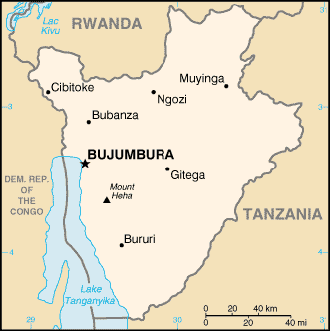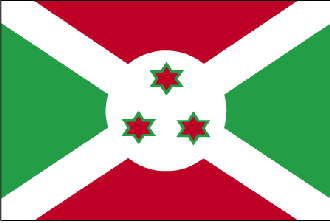
|
Burundi
Background:
Burundi's first democratically elected president was assassinated in October
1993 after only four months in office. Since then, some 200,000 Burundians have
perished in widespread, often intense ethnic violence between Hutu and Tutsi
factions. Hundreds of thousands have been internally displaced or have become
refugees in neighboring countries. Burundi troops, seeking to secure their
borders, intervened in the conflict in the Democratic Republic of the Congo in
1998. More recently, many of these troops have been redeployed back to Burundi
to deal with periodic upsurges in rebel activity. A new transitional
government, inaugurated on 1 November 2001, was to be the first step toward
holding national elections in three years.
Location:
Location: Central Africa, east of Democratic Republic of the Congo.
Area: Total: 27,830 sq km, water: 2,180 sq km, land: 25,650 sq km.
Area - comparative: Slightly smaller than Maryland.
Land boundaries: Total: 974 km, border countries: Democratic Republic of the
Congo 233 km, Rwanda 290 km, Tanzania 451 km.
Coastline: 0 km (landlocked)
Climate and Terrain:
Climate: Equatorial; high plateau with considerable altitude variation (772 m
to 2,670 m above sea level); average annual temperature varies with altitude
from 23 to 17 degrees centigrade but is generally moderate as the average
altitude is about 1,700 m; average annual rainfall is about 150 cm; wet seasons
from February to May and September to November, and dry seasons from June to
August and December to January.
Terrain: Hilly and mountainous, dropping to a plateau in east, some plains.
People:
Population: 6,096,156.
Ethnic groups: Hutu (Bantu) 85%, Tutsi (Hamitic) 14%, Twa (Pygmy) 1%, Europeans
3,000, South Asians 2,000.
Religions: Christian 67% (Roman Catholic 62%, Protestant 5%), indigenous
beliefs 23%, Muslim 10%.
Languages: Kirundi (official), French (official), Swahili (along Lake
Tanganyika and in the Bujumbura area.)
Government:
Economy overview:
Burundi is a landlocked, resource-poor country with an underdeveloped
manufacturing sector. The economy is predominantly agricultural with roughly
90% of the population dependent on subsistence agriculture. Economic growth
depends on coffee and tea exports, which account for 90% of foreign exchange
earnings. The ability to pay for imports, therefore, rests primarily on weather
conditions and international coffee and tea prices. The Tutsi minority, 14% of
the population, dominates the government and the coffee trade at the expense of
the Hutu majority, 85% of the population. Since October 1993 an ethnic-based
war has resulted in the death of over 200,000 persons, sent 800,000 refugees
into Tanzania, and displaced 525,000 others internally. .
Statistics:
Telephones - main lines in use: 18,000.
Telephones - mobile cellular: 30,000.
Radio broadcast stations: AM 0, FM 4, shortwave 1.
Radios: 440,000.
Television broadcast stations: 1.
Televisions: 25,000.
Internet users: 6,000.
Railways: 0 km.
Highways: Total: 14,480 km, paved: 1,028 km, unpaved: 13,452 km.
Airports - with paved runways: 1, with unpaved runways: 6.
Return to Visiting Locations
|

